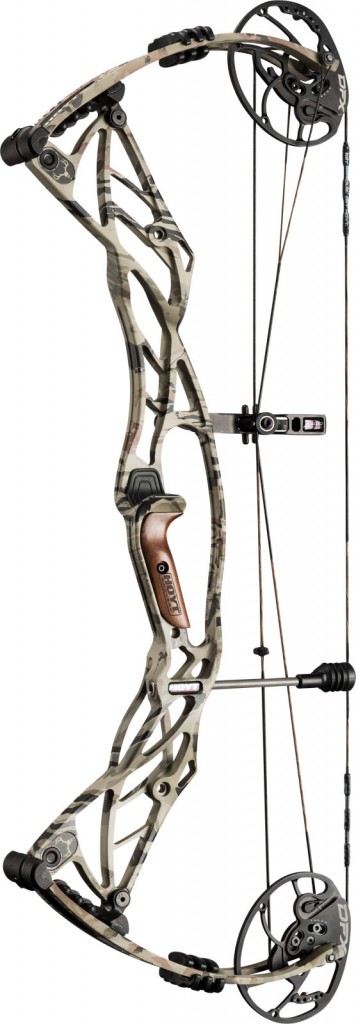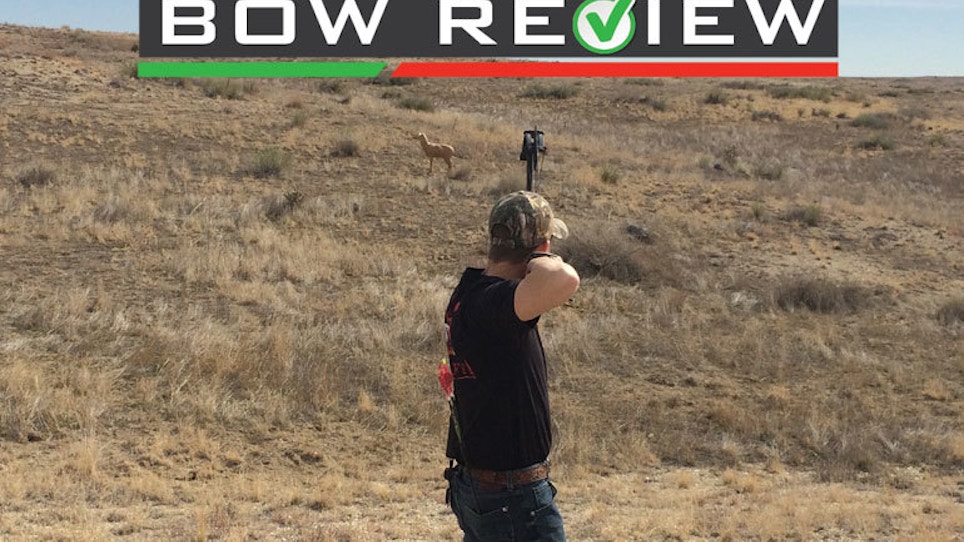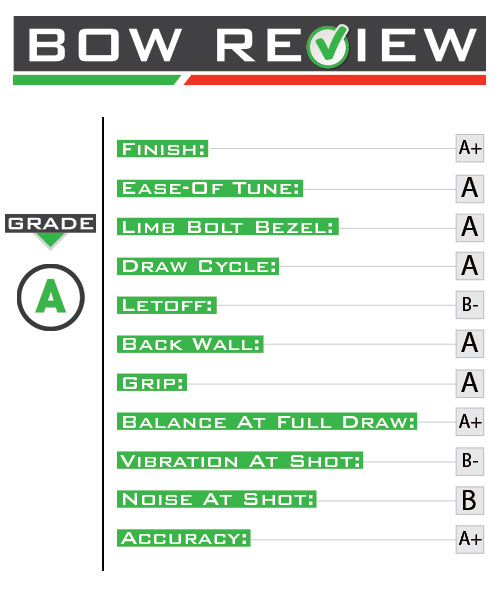I know I noted in my report on the Bear Escape that I wasn’t much of a speed demon, but I must admit 2016’s speed bow crop is growing on me. Wow! So much speed with zero – and I mean zero – sacrifice when it comes to accuracy. More on this later.
 I’ve always loved the look of a Hoyt, and the Defiant Turbo was no different. Measuring 33 inches axle to axle (I know I’m biased, but this measurement is my favorite axle-to-axle length) and cloaked in a midnight-black finish, the Defiant Turbo had zero blemishes. Its UltraFlex Limbs just look fast, and filling the air in between the split top and bottom limbs are Hoyt’s nightmare-for-noise-and-vibration Limb Shox. The Tec Lite riser, at first glance, appears longer than it actually is and showcases Offset Riser Technology. The bow is, in a word, breathtaking.
I’ve always loved the look of a Hoyt, and the Defiant Turbo was no different. Measuring 33 inches axle to axle (I know I’m biased, but this measurement is my favorite axle-to-axle length) and cloaked in a midnight-black finish, the Defiant Turbo had zero blemishes. Its UltraFlex Limbs just look fast, and filling the air in between the split top and bottom limbs are Hoyt’s nightmare-for-noise-and-vibration Limb Shox. The Tec Lite riser, at first glance, appears longer than it actually is and showcases Offset Riser Technology. The bow is, in a word, breathtaking.
A Hoyt first, the DFX Turbo Cams are draw-length adjustable depending on the cam option you order. Because my draw length is 29 inches, I opted for the #3 cam, which is draw-length adjustable in ½-inch increments between 28 and 30 inches. I love this new feature. In addition, Hoyt has given those must-have-a-solid-back-wall lovers the option of adding the new Hoyt limb stop. I opted to go without the limb stop, as I appreciated the back wall just as it was without the addition.
Like This? Check Out All Our Bow Report Cards
The limb bolts turned easily. There was zero popping or chattering, and after backing my limbs out a total of three turns, I pressed the bow with my Last Chance Archery EZ Press Deluxe Press. The micro-adjust screws on the press arms allowed me to quickly and easily bring the fingers over both the top and bottom split limbs, and the bow pressed with ease.
After installing my QAD UltraRest HDX and G5 Meta Peep 5/16-inch peep, I was ready for paper. (Yes, I shoot a big peep. I’m not a tournament shooter and have found that a bigger peep provides more light when I need it most. In addition, I’ve noticed very little, if any, accuracy hindrance at longer ranges.) My first shot didn’t go as planned. Yes, the speed bow was noticeably quiet and produced only a minute amount of hand shock, but my arrow tear through paper was awful. The arrow created a monster left tear, and this sent me back to the drawing board. I’m happy to report this error was all mine. In my rush to get the bow set up, I’d forgotten the pivotal task of using my R.S. Bow-Vise String Level and hadn’t even adjusted the left/right horizontal on my rest. NOTE: Slow down and smell the roses when tuning any bow. I was in such a hurry to get to shoot the racy rig, I actually doubled my set-up time. Three shots after getting my head back, I was bullet-hole perfect. NOTE: I did a small report on the Defiant Turbo earlier in the year in which I noted my first shot was bullet-hole perfect. My current test was performed after installing a custom set of Wolfpack Outdoors Strings and Cables.
For my first 20-yard group I shot three 9.6-grains-per-inch 330 Easton BowFire arrows (394 grains total per arrow) tipped with a field point, broadhead and fixed-blade head into my Rinehart target. Aside from being satisfied with the 302 fps speed rating (65-pound draw weight and with a heavy arrow) on my chronograph, I was also thrilled to see each of the arrows inside their respective two-inch dots. This accuracy was evident out to a tested distance of 120 yards.
I will say that I shot this bow better than any Hoyt I’ve gripped in the past, including my all-time favorite Hoyt model, the AlphaMax 32 (loved that thing). Why? For starters, the bow was extremely balanced and the rig’s UltraFlex Limb design and DFX Cam System work in perfect harmony to deliver what Hoyt is calling “a dramatically broader string angle, an increased full-draw axle-to-axle measurement and more optimal peep positon.” I can say without question this bow actually felt longer than it was, and I had reduced facial contact. I shot four different three-arrow groups at a distance of 120 yards and held sub-7-inch groups. For me, and for how I shoot, this was incredible.
Set at 65 pounds, my Defiant Turbo (4.2-pound mass weight without accessories) drew with a much-appreciated gentleness. Transition to the bow’s letoff was a bit abrupt, but before long I could easily control it without bouncing my arrow inside my rest. At the shot, as I noted earlier, there is noticeable hand vibration – slight, but noticeable. Noise is minimal, and I had no trouble shooting literally hundreds of arrows a day for several weeks with this bow.
Spring is just around the corner, and I can’t wait to anchor a few springtime butterballs with my Defiant Turbo. This is a bow that shoots extremely well, is super accurate and provides incredible balance at full draw.







